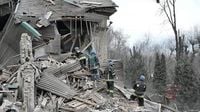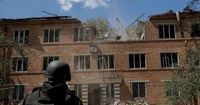Ukraine is accelerating its military capabilities through a series of significant agreements and arms deals with the United States and its European allies, marking a pivotal moment in the ongoing conflict with Russia. President Volodymyr Zelenskyy recently announced a landmark deal with U.S. President Donald Trump, under which Ukraine will sell its advanced drones to the United States in a contract estimated to be worth between $10 billion and $30 billion. This "win-win" arrangement not only strengthens Kyiv’s drone industry but also facilitates the acquisition of U.S. weapons to bolster Ukraine’s defense.
Speaking to journalists on July 24, 2025, Zelenskyy confirmed the drone deal and revealed that oversight of the contracts will be managed by key Ukrainian officials, including National Security and Defense Council Secretary Rustem Umerov, Defense Minister Denys Shmyhal, and presidential advisor Oleksandr Kamyshin. This agreement is part of a broader strategy to relocate elements of Ukraine's weapons production abroad, with ongoing negotiations involving Denmark, Norway, and Germany to establish joint manufacturing facilities.
Denmark, for example, has committed to setting up production lines for long-range drones, providing additional funding estimated between $100 million and $300 million. These drones will be produced in a 50/50 partnership with the private sector, supplying Ukraine during the war while stockpiling for Denmark's military needs afterward. Since the full-scale Russian invasion in 2022, Ukraine has dramatically expanded its drone production across air, land, and sea domains, aiming to manufacture 30,000 long-range drones in 2025 alone. Ukrainian hybrid strike platforms like the Palianytsia and Peklo missile-drones have garnered international attention for their precision and extended strike range, underscoring Kyiv’s growing technological edge.
In a demonstration of this capability, on June 1, 2025, Ukraine executed Operation Spiderweb, a drone strike targeting four Russian air bases deep inside Russia using first-person view (FPV) drones—a milestone in modern warfare.
Complementing this drone deal, the U.S. State Department announced on July 23, 2025, approval of $322 million in proposed weapons sales to Ukraine. These include $150 million for armored vehicle supply, maintenance, repair, and overhaul, and $172 million for surface-to-air missile systems. This announcement follows a brief pause in weapons shipments ordered by Defense Secretary Pete Hegseth, which surprised the White House. However, President Trump reversed course earlier in July, pledging to continue sending primarily defensive weapons to Ukraine, stating, "We have to. They have to be able to defend themselves. They’re getting hit very hard now. We’re going to send some more weapons — defensive weapons primarily." Trump also endorsed a plan for European allies to purchase U.S. military equipment for transfer to Kyiv, though details on how this meshes with the latest sales remain unclear.
Since Russia’s invasion in February 2022, the U.S. has provided over $67 billion in weapons and security assistance to Ukraine. Yet, the Trump administration’s stance on aid has fluctuated due to political pressures within Washington, reflecting broader debates about U.S. involvement in foreign conflicts.
Adding to Ukraine’s defensive arsenal, Zelenskyy announced on July 25, 2025, that Ukraine has secured funding for three Patriot missile defense systems and is negotiating to acquire seven more. This development follows a deal enabling Ukraine’s European allies to buy U.S. military equipment and supply it to Kyiv. Zelenskyy confirmed, "The US president will be transferring, selling these systems to us. Our task is to find funding for all 10 systems." Germany has committed to two systems, Norway to one, and talks are ongoing with the Netherlands.
These Patriot systems are crucial for countering Russian ballistic missile attacks and represent a significant upgrade to Ukraine’s air defense capabilities. The deal aligns with President Trump’s recent 50-day ultimatum to Russia, demanding a war settlement or the imposition of severe tariffs. Despite the ultimatum and ongoing diplomatic efforts, including talks in Istanbul on July 23, 2025, no major progress has been made, and Russian drone and missile strikes continue to target Ukrainian cities.
One such attack occurred early on July 25, when Russian forces struck a hospital in Kharkiv treating tuberculosis patients. Regional governor Oleh Synehubov reported at least a dozen injuries, including a teenage girl. Natalia Trokhlebova, acting chief of the facility, described the damage: "The roof of the third floor was struck... A common medical ward is located there," but noted that the floor was closed and few patients were present, mitigating potential casualties.
Zelenskyy suggested these attacks might be retaliatory responses to Kyiv’s proposal for an immediate cease-fire, which its delegation advocated during the Istanbul negotiations.
Overall, these developments underscore a complex, evolving military and diplomatic landscape. Ukraine is not only enhancing its own defense capabilities but also engaging in strategic partnerships to sustain and expand its military production beyond its borders. Meanwhile, the U.S. and its allies are navigating domestic political pressures and international diplomacy to maintain support for Kyiv amid an increasingly volatile conflict.
With drone technology becoming a central component of modern warfare and Patriot missile systems bolstering air defense, Ukraine’s military strategy is adapting swiftly to the challenges posed by Russia’s aggression. The intertwining of arms sales, international cooperation, and battlefield innovation paints a picture of a nation determined to defend its sovereignty while reshaping the future of military technology and alliances.


